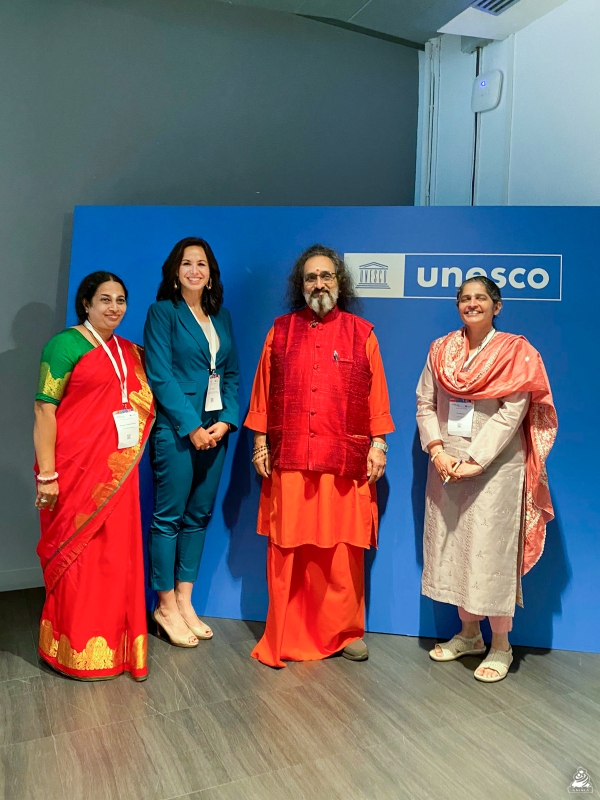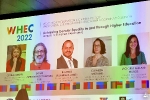The WHEC aimed to reshape ideas and practices in higher education to ensure sustainable development for the planet and humanity, as well as to define and prepare a roadmap for a new era of higher education.
Swami Amritaswarupananda participated in a round table “Universities’ Contribution to Gender Equality: A global perspective”. He was asked key questions on how Amrita is making a difference in terms of gender equality and which policies have been put into place at the university level. Gender equality is number five in the United Nations’ list of 17 Sustainable Development Goals (SDGs).
He explained how the culture of gender equality is not implemented only in terms of policies within Amrita, but also practiced in spirit under the guidance and inspiration of our Chancellor, Sri Mata Amritanandamayi Devi.
The round table included Dr. Gloria Bonder, UNESCO Chair on Women, Science & Technology; Dr. Ricardo Vilanueva Lomeli, Rector General, University of Guadalajara; Ms. Elizabeth Shepherd, Leader of the Consultancy Team, Times Higher Education; and Dr. Victoria Galan-Muros, Chief of Research & Analysis, UNESCO.
During the session, an international report published by UNESCO, Times Higher Education (THE), and the Institute for English Literacy (IELSAC) was presented on how global universities are performing in terms of gender equality. The report showcased Amrita as a case study for excellence in institutions for promoting SDG5: Achieve gender equality and empower all women and girls.
More than 2,000 stakeholders attended the WHEC in person in Barcelona and 10,000 participated online, including intergovernmental organizations, UNESCO Chairs, university networks, regional organizations and development banks, country policymakers, universities, researchers, leaders of community service programs, students and youth organizations, the private sector, NGOs and civil society groups.
UNESCO considers the process of collective construction as the greatest richness of this gathering, and that vision was expressed well in terms of the diversity of participants. Within the big picture of ensuring that no one is left behind in education, the WHEC focused on five goals:
1. Opening the door to new, innovative, creative, and visionary models of higher education.
2. Highlight higher education opportunities and priorities in the upcoming decade.
3. Anticipate and prepare youth for their role in tomorrow’s society.
4. Pave the way for a future learning community that is inclusive of all lifelong learners.
5. Define and prepare the roadmap for a new era of higher education systems.
With the youth of today as the leaders of tomorrow, the WHEC includes a platform for young people that fosters an open knowledge collective process, innovation in entrepreneurship, and artistic expression to teach problem-solving.
Photo 1: Swami Amritaswarupananda took part in a session that addressed achieving gender equality in institutions of higher learning.
Photo 2: Dr. Maneesha Ramesh, Swami Amritaswarupananda, and Dr. Bhavani Rao represented Amrita at the UNESCO World Higher Education Conference 2022.
Photo 3: The speakers in Swami Amritaswarupananda’s session included Dr. Gloria Bonder, UNESCO Chair on Women, Science and Technology; Dr. Ricardo Vilanueva Lomeli, Rector General, University of Guadalajara; Ms. Elisabeth Shepherd, Leader of the Consultancy team, Times Higher Education; and Dr. Victoria Galan-Muros, Chief of Research and Analysis, UNESCO.
Photo 4: Dr. Ramesh, Dr. Galan-Muros with UNESCO, Swami Amritaswarupananda, and Dr. Rao connected with people from institutions of higher learning from across the globe.








